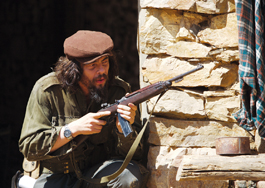home | metro silicon valley index | movies | current reviews | film review

Photograph by Teresa Isasi
LOCK AND LOAD: Benicio Del Toro's Che Guevara takes direct political action in Steven Soderbergh's biopic.
Guerrilla Filmmaking
Steve Soderbergh and Benicio Del Toro tell the story of revolutionary icon Che Guevara in two-part epic
By Richard von Busack
I DON'T WANT to touch the relative evil or good of Che Guevara's career. If you believe the right-wing blogosphere, Che was responsible for 14,000 executions. Still preserved in Internet ether is Paul Berman's Slate.com piece about the cult of Che, written when The Motorcycle Diaries came out. (Berman's own soapbox is somewhat diminished after his decision to bunk up with The Men Who Would Be Kings of Iraq.)
I personally wouldn't wear a Che T-shirt for exactly the same reason that Che wouldn't wear a me T-shirt. Whether in Oaxaca or the Mission, when Che's face appears, it's always apparent what's being said. People have appropriated this indomitable revolutionary's face as an icon against economic policies that have left a substantial part of the world starved and ruined. If they are wearing Che's image in some smarmy cafe while sipping coffee, it's just another contradiction. Not being Che, I can live with contradictions.
Anyway, Che's career as a guerrilla general isn't as arguable as his tactics. Steven Soderbergh's absolutely to be celebrated epic about Che Guevara, Che, produced by and starring Benicio Del Toro, takes Che at his word. The film insists that self-sacrificing love makes a revolutionary risk his life. Let's stress that Soderbergh doesn't turn Che into Jesus in a beret. The much-quoted line "A revolutionary is motivated by true feelings of love" is heard in voice-over as Che puts that love in action by aiming and firing at a line of Batista's troops walking through a banana plantation.
Soderbergh's two-part (shown back to back at some theaters in a roadshow version), large-scale, yet bracingly low-key story of Guevara's career moves over 13 years. It begins in an exile's apartment in Mexico City in the mid-1950s and finishes in the Bolivian mountains in 1967. The hinge of Che: Part One consists of flash-forwards from the Cuban revolution; the film shuttles between the jungle and Guevara's trip in 1964 to the U.N., filmed in black-and-white. In that city, Che, now a state official, answers the Oriana Fallaci–worthy questions of a journalist (Julie Ormond).
Ultimately, Che: Part Two, seems more hurried. Maybe that is because there's nothing to cut back to from Che's endgame in Bolivia, except the moral questions: What kind of "help" it is to poor farmers to forcibly buy or steal their goods.
More could have been made, perhaps, of the story of Tania (Franka Potente). The matter of Che's mission into Bolivia as foreign aggression is countered nicely, though; President Barrientos (Joaquim de Almeida) himself has to call in the CIA to handle these guerrillas.
Soderbergh decides to leave the atrocities of the Bolivian government offscreen. It's rare to see a movie about revolutionaries that's so delicate about pumping up revolutionary fervor; one of the most powerful stories of injustice is told, half-whispered by a Cuban campesino. And on the other side of the line, Soderbergh gives all emphasis to Che proudly stating, "We've executed, and we'll continue to execute as necessary," during his speech at the U.N.
Demián Bichir's Fidel Castro is feline and silky; he lolls on his camp bed smoking his cigar when he gives orders. Soderbergh handles Fidel the way any sensible person would—with tongs. He stages Fidel's reading of Che's final letter to the Cubans on a TV set placed too close to the camera. In Che as in real life, what you see on TV is not to be trusted.
Soderbergh's good common sense, and his extensive visual vocabulary, makes this big movie enthralling. He keeps it right between under- and overproduced, filming his tale of two nations in parts of Puerto Rico, Mexico, Bolivia and Spain. A billow of blue sea and Del Toro's tight, haunted face make up the voyage of the Granma. The last stand of Batista takes place in the Cuban town of Santa Clara in street-to-street fighting, with Che's troops sledge-hammering through walls to get to the highest point in town, the church roof. Meanwhile another squad of Che's soldiers derail a troop train. Our eye is on a dog leaping down the street; the animal feints toward the tracks and then is startled away by the screech of the train's arrival. The scenes of the guerrilla fighting show why Defiance is such a bore.
Each battle in Che is urgent; I never knew how sick I was of impressionistic freeze-frame-loaded war-movie scenes until I saw such clean, well-considered compositions. When Bolivian troops overwhelm the sick and worn-down revolutionaries, Soderbergh revives a great shot from the old Western movies: the horizon is a clear sharp shadow, and then, in the distance, a head pokes over the horizon line—then dozens of heads right after it.
The key death scene—the last one—is an impressive point-of-view shot. It should have been too fancy but somehow seems graceful as well as grave, detached as well as emotional; the movie is good to the last drop.
![]() CHE: PART ONE and CHE: PART TWO (R; 129 min. and 128 min.), directed and photographed by Steven Soderbergh, written by Peter Buchman and starring Benicio Del Toro, opens Jan. 23 at the Aquarius in Palo Alto and Jan. 30 in San Jose at Camera 3.
CHE: PART ONE and CHE: PART TWO (R; 129 min. and 128 min.), directed and photographed by Steven Soderbergh, written by Peter Buchman and starring Benicio Del Toro, opens Jan. 23 at the Aquarius in Palo Alto and Jan. 30 in San Jose at Camera 3.
Click Here to Talk About Movies at Metro's New Blog
Send a letter to the editor about this story.
|
|
|
|
|
|